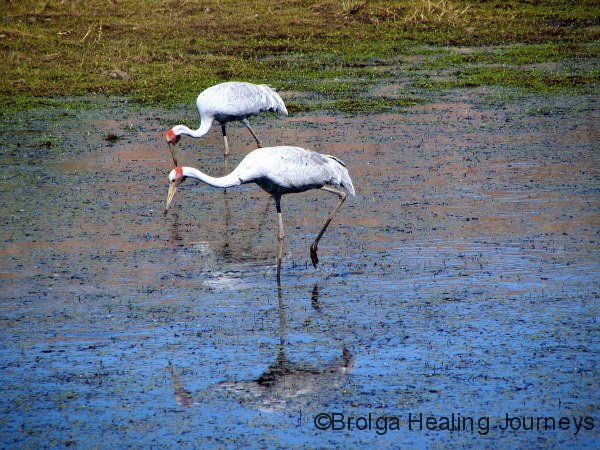Brolgas
What’s going on here? We’re running a website called brolgahealingjourneys, and we don’t have any pictures of Brolgas on the site. To tell the truth, we had a really frustrating time waiting to see our first Brolgas on our travels. We had seen plenty of Brolgas on a previous trip, in 2002, to the Kimberley. In fact, the huge flocks of Brolgas we saw at that time, on the shores of Lake Gregory, itself on the edge of the Great Sandy Desert, provided the inspiration for this website’s name.
But this time around things were different. We commenced our travels in July 2007 and it wasn’t until late June 2009 that we had our first sighting. It was with a mixture of excitement and blessed relief that we watched a small flock of Brolgas jump and dance on the far edge of a pond at Cape Keraudren, on the southern tip of Eighty Mile Beach in WA. We too jumped and danced, to see Brolgas again. The Brolgas were a long way off, the sun was in our eyes, we only managed a few grainy photos and a short blurry video, but we didn’t care. At long last we had seen some Brolgas!!

Since then, we have encountered these beautiful birds again and again, most notably through the Kimberley, where nature still holds prominence over human-kind. They are a bird of great elegance. They hold you spellbound as they patiently patrol through the shallow waters of ponds and billabongs, lifting their long legs with complete control and stepping with apparent care. They are most often seen in pairs, sometimes alone, and sometimes, when you are especially lucky, in flocks. As they fly overhead they trumpet, a deep resonant sound; to our ears uncannily reminiscent of the didgeridoo. Hearing them caused us to wonder whether they were the inspiration for that most Australian of all instruments.
We had a juvenile, orphaned Brolga as company when we camped at Parry Creek Farm near Wyndham in the north eastern Kimberley. She was caught between two worlds, accustomed to the company of humans but just starting to feel the call of the wild and listen to the songs of her own kind in the distance. We like to think that she would now be part of a Brolga flock somewhere up north.
We stayed at Gurrandalng – the Brolga Dreaming site – in Keep River National Park, just across the border in the Northern Territory, but as far as nature was concerned, very much a part of the Kimberley. We were there at the end of the dry, at the start of the buildup. The weather was hellishingly hot and humid, the grasses tall and dry, no water to be seen and certainly no Brolgas to be found. But this powerful place contained the essence of the Brolga and we would love to be there at the end of the wet, when the Brolgas make it all their own.
Gurrandalng had a real presence, revealing different aspects of itself to us as the light changed throughout the day. You can imagine our excitement when we learned that Gurrandalng means Brolga Dreaming to the Mirriwoong and Gajirrabeng people. Their Brolga dreaming story is as follows:
In the Dreamtime two Aboriginal people travelled from the sea to this area. They collected grass and bushes, made a large nest and started to jump around and make noises like a Gurrandalng (Brolga). As the country listened they changed into Brolgas. The place is named Gurrandalm – the place of Gurrandalng.
We are sometimes asked why we chose the name brolgahealingjourneys for our website and our business. There are a number of reasons for our choice of Brolga in that name, some spiritual and some, to be honest, rather mundane. We both love birds. The Brolga is one of Australia’s most beloved birds, and for us recalled memories of a life-changing journey we made in 2002 through the Kimberley.
In some esoteric traditions, birds represent a connection between Heaven and Earth, being able to fly as they do in the skies, but also to live on the land. The Brolga, as a bird, therefore serves as a reminder to us that while we have our earthly lives to lead, there is also a spiritual aspect to our lives.
The dance of the Brolga is famous as a beautiful mating ritual, but can also be seen as representing something deeper – a celebration of life and renewal, conveying a sense of joie de vie . The Australian Aboriginals regard it as a sacred dance.
In Tai Chi, there is a well known movement called White Crane Spreads Wings. The Brolga, interestingly, in also known as the Australian Crane, so for me there is a connection between the elegant movement of the Brolga and what I have been trying to achieve (mostly in vain, I should add) over many years in my Tai Chi practice.
Nirbeeja, apart from her deep love of all things avian, is also a great lover of ballet. Like all tall waterbirds, the Brolga has a particulary balletic quality to its movements.
So, really, there were many connections between our journey and the Brolga. And we love them simply for being what they are.
We captured a short video of Brolgas dancing at Cape Keraudren. It is short, noisy, blurry and taken from a distance. But we don’t care, because it’s Brolgas.
Click on the following to link to watch:










